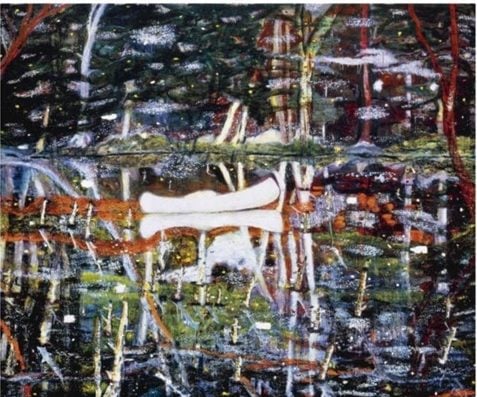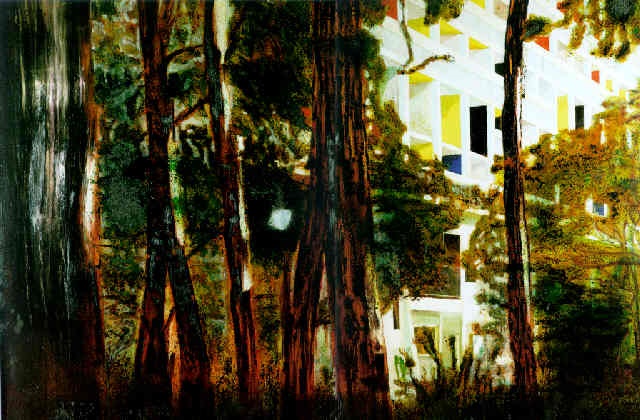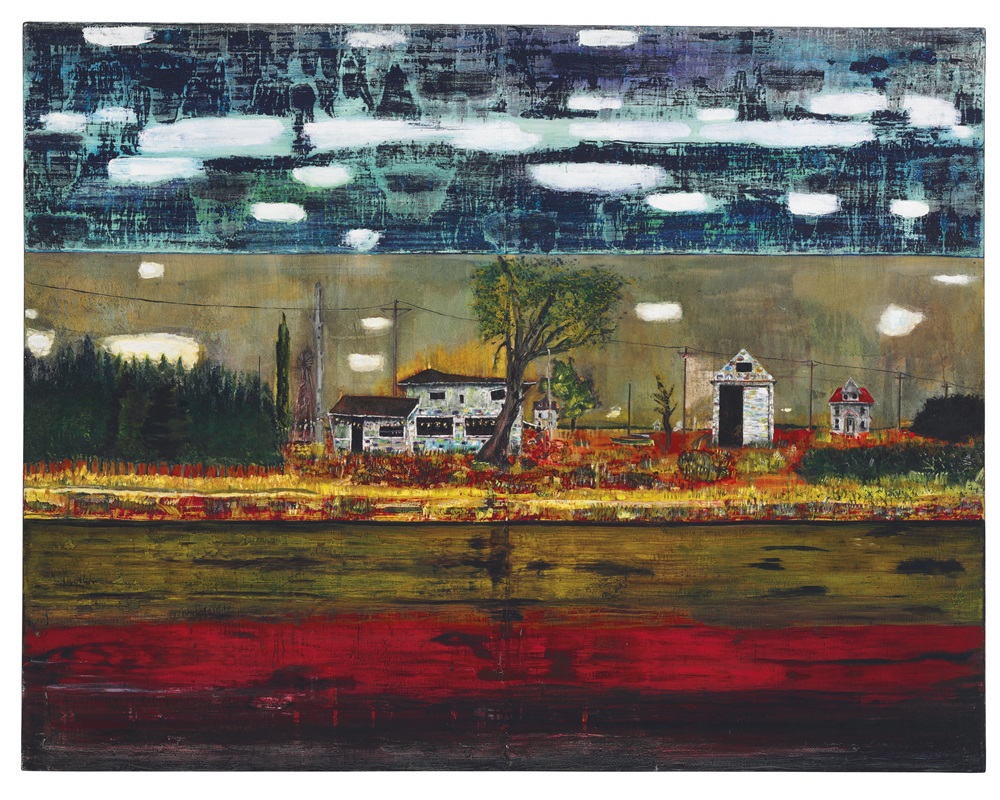Analysis
Art World Report Card: the Meteoric Rise of Peter Doig (updated)
Breaking down Peter Doig as an art world phenomenon.

Breaking down Peter Doig as an art world phenomenon.

Alexandra Peers

A work by landscape painter Peter Doig, 55, has sold for £7.5 million, or just under $13 million, at an auction in London, setting a record for the artist’s work.
The stellar sale June 30 was still a minor letdown: Doig’s Country Rock (Wing-Mirror) (1995) had been on the block at Sotheby’s with an “estimate on request” of £9 million. And the Scottish artist’s cult of fans had hoped the sale might break Damien Hirst’s record as the priciest living UK artist. (At $17.3 million, that Hirst record still stands.)
Nonetheless, Doig’s climb has been meteoric and has now hit new heights. And much like David Byrne of the Talking Heads, he might look around and ask himself, “Well, how did I get here?”
Especially in the art world, these things do not happen by chance. To people who’ve never heard of the Scottish-born painter, his may look like overnight, even accidental, success—but that couldn’t be further from the truth. Throughout Peter Doig’s career, there’s been a widening web of bold-faced name collectors, influential curators and powerhouse dealers who’ve been believing in him, or betting on his striking, mystical memorable landscapes, for the last 24 years.
Here’s a look at the arc of a career:
1979–1990 Doig, 20, moves to London in 1979 and attends a trio of art schools. He’s included in the New Contemporaries show at the Institute of Contemporary Art, London, England in 1982 and 1983.
1990 He begins work on the moody lakeside scene of an empty canoe, White Canoe, inspired by the memorable penultimate scene of horror classic “Friday the 13th.” He’ll later say the movie scene reminded him of an Edvard Munch.
1991 Artists flood London as the Young British Artists phenomenon takes off, but most of their work gets lost in the shuffle. Doig, defying YBA style fads, doesn’t. He wins the Barclays Young Artist Award Serpentine Gallery. Around this time, Charles Saatchi, known for his eye, and for flipping young art for profit, begins to attend Doig exhibitions, the artist will tell interviewers years later, but doesn’t yet buy.
1992 A Frieze magazine article by curator Gareth Jones compares him, perceptively, to Caspar David Friedrich and Edward Hopper; Jones curates a show of his work the same year. Doig also shows at the powerhouse Whitechapel.
1994 His watercolors are offered for a few thousand dollars at the historic and packed New York’s Gramercy Park Hotel art fair, founded by Paul Morris, who will later helm the Armory Show for decades. In June, he’s nominated for the Turner Prize, England’s art “Oscar.” But loses to sculptor Antony Gormley.
1995 Britain’s Tate Museum names Doig a trustee.
1998 Doig’s first sale at auction is a work on paper; it brings $3,622. But the Tate Museum buys Doig’s oil Echo Lake, for $38,500, reportedly from dealer Victoria Miro. Scandal ensues!: The Tate will later be sanctioned for buying trustee art without an independent appraisal.
1999 Doig’s US dealer Gavin Brown skyrockets to art world stardom. His artist Chris Ofili, a close friend of Doig’s, draws fire for a dung-dotted portrait of the Virgin Mary in the Brooklyn Museum’s “Sensation” show.
2000 Doig’s Concrete Cabin (1995) sells for $156,500 at Phillips de Pury’s evening auction in New York. Eight years later, it will sell for $2.1 million at Sotheby’s.

Peter Doig, Concrete Cabin (1994). Courtesy of Phillips.
1995–2002 Doig’s relatively slow output of art prompts wait-lists for collectors who want one. Influential collectors add Doigs: Software pioneer Peter Norton buys Doig’s painting Corn Cob (1994), and gifts it to an LA Museum; Mira and Don Rubell (brother of Studio 54 founder Steve) start collecting; Saatchi adds several.
2004 Artist Alex Katz curates an influential show of important new art that includes a Doig. The Museum of Modern Art opens its new building. Its keenly anticipated exhibition of emerging art includes a freshly painted Doig. The artist was deemed so important, the show’s curator Ann Temkin says, MoMA commissioned the work. You can make a case that Temkin’s support alone is enough to build his career.
2005 He’s featured in the Saatchi Gallery’s “The Triumph of Painting I.” In Florida, Selfridges heiress Alannah Weston, one of the richest women in Canada, flies collectors at the Art Basel Miami Fair to Vero Beach to see both a Doig show—and her family’s New Urbanism–planned community for the über-wealthy, Windsor. The show travels to Dallas Museum of Art and the Art Gallery of Ontario.
2006 Doig is included in The Whitney Biennial. The artist cracks $1 million at auction. In September, in an almost unprecedented transaction, auctioneer Sotheby’s takes a position in the artist, buying seven paintings from Saatchi for a reported $11 million. A 15-inch high version of Tunnel passing (Country-rock) (2000), similar to the artwork for sale June 30 but far smaller, sells for $114,000 at Phillips.
2007 White Canoe, the 1990–1991 painting inspired by the horror movie, goes on sale at Sotheby’s with a $1.5 million estimate. In a bidding war, the price climbs to $11.3 million. The anonymous buyer is Boris Ivanishvili, a Russian collector whose fortune was made in ore-mining and banking. (David Nahmad, the powerhouse Monaco art dealer whose son is later to become embroiled in a money-laundering scandal, famously sputters at an Art Basel luncheon in Switzerland that it is “ridiculous” that Doigs are going for more than Picassos and Dubuffets.)
2009 A joint show at Michael Werner and Gavin Brown in New York earns rivers of critical praise. “Doig’s effects are often wizardly: He can make oil look like diaphanous watercolor, distorted pictorial scale register as naturalistic, abstraction slide smoothly into figuration and vice versa,” raves Artforum. In Time Out New York, Howard Halle notes the paintings are beautiful and added that some of “the work suggests what would happen if Whistler mugged Rothko in a back alley.”

Peter Doig, Road House (1991). Sold for $11.9 million at Christie’s in it’s May 12 contemporary art sale. Photo: Courtesy of Christie’s.
2011 Doig is invited to do a series of artworks for The Metropolitan Opera in connection with its performance of Wagner’s Ring cycle.
2012 In a rare interview with The Guardian, (he’ll go on to do a slew more by year’s end in connection with a Werner exhibition in London) Doig says he was nauseated by the record price for Canoe and “the pressure it put me under.” He was delighted when Lucian Freud “gazumped me” with a higher record price, he adds. “Deservedly so.”
2013 “Peter Doig: No Foreign Lands” opens at the Scottish National Gallery. But, with years of residence in Scotland, London, Canada and Trinidad, a quartet of countries can claim the artist as a native son, and do.
2014 The Museum of Modern Art’s collection of Doigs reaches 33 artworks, including paintings, prints and drawings.
The bottom line: Peter Doig’s landscape paintings—variously called mysterious, fairy-like, ephemeral, simultaneously figurative and abstract—don’t look like everyone else’s, or rather, they look like everyone else’s, with critics, as we’ve seen, evoking Old Masters to Expressionists to Color Field painters to describe them. His cult has gone mainstream and for good or ill, he’s on the cusp of becoming, in terms of his talent, a household name.
Damien, watch your back.
Art World Report Card appears every Thursday. Contact the author at [email protected] or follow her on Twitter @LoisLaneNY.